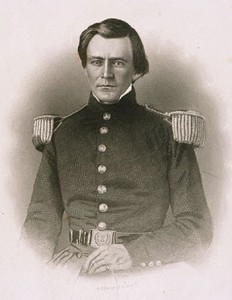In April of 1852 Lt. Ulysses S. Grant and eight companies of the 4th Infantry Regiment assembled with their families on Governor’s Island in New York Harbor. Passage to Panama was secured at the last minute on the SS Ohio, a steamship of the U.S. Mail Steamship Co. and the ship left port on July 5th. Arrangements were also made for the regiment, its equipment, supplies and dependents to cross the isthmus and board a Pacific Mail Steamship to California. From the outset things went wrong. The Ohio already had booked a large number of passengers and the addition of the 700 persons of the 4th overcrowded her and proved increasingly uncomfortable in the summer heat and worsened in the tropics.
After eight days the Ohio arrived in the port of Aspinwall, founded in 1850 as the starting point for the Panama Railway. Here rain would pour down so hard that streets were under eight to ten inches of water. People went from place to place on raised wooden walkways. Then a blazing sun would appear. This alternating pattern of rain and sun happened a number of times each day.
From the town the soldiers took the yet unfinished Panama railroad as far as the Chagres River. They were ferried upriver in boats that held 30-40 people. Six natives would put one end of a long pole against the river bottom and walk toward the stern along a plank at the edge of the craft thus pushing the boat upstream at about one mile an hour. It was slow progress to the jungle village of Gorgona where the regiment would disembark and take mules and horses overland to the town of Panama on the Pacific coast.
But they soon found that the promises of transportation made in New York could not be met. The large number of passengers on the Ohio overtaxed the capacity of the Panamanians to provide the needed mounts. While there were enough animals for most of the soldiers there were none for the supplies and equipment. Lt. Grant, with one company of troops, soldiers with families, tents, mess camp kettles and other gear, was sent to Cruces, a town a few miles farther up the Chagres River, to work out a solution. But in Cruces there were still no horses or mules and for days none appeared. Then cholera broke out. Men died by the hour. Grant was forced to find animals from the locals at more than double the original price. A third of those with him in Cruces died. In Panama City the steamship Captain refused to sail until the threat of cholera was gone. The regiment was delayed a total of six weeks and lost around one-seventh of those who had sailed with them. Finally, in early September, the 4th Infantry Regiment arrived in San Francisco.



















An interesting bit of early history on Grant. I just can’t imagine making the trip. We sometimes forget what it took for our ancestors to make the mark on history they did. Thank you, I really enjoyed this post.
That must have been a tough trip. Ironically malaria and yellow fever were the dread diseases in Panama and cholera hit the grant party in the mountains and out of the mosquito zone. I saw a PBS show on the Panama Canal last night. They had problems in all the same places as early Panama travelers had. I get occasional emails or comments from people who tell me their relative came to the gold rush but got sick in Panama coming home and later died. It was a dangerous place.
What about the totality of the human tragedy suffered by the children and families of our soldiers? Was Grant not the nursemaid to the entire unit and did all the children not succumb to the disease? If so, this unbelievable history of Grant and his unit cannot be overlooked. Imagine the trauma. Thank you.
Gene, Panama was full of many diseases no one yet understood. Grant certainly didn’t. Yet he was a soldier. Death is part of the job. Thanks for writing.